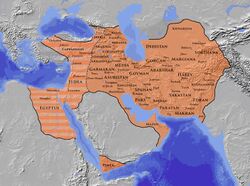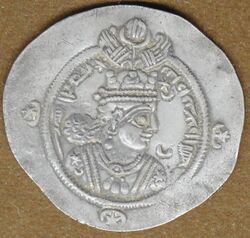Were Sasanian Persian Border Defenses Effective
The Sasanian Empire (AD 224-651) was the last pre-Islamic Persian Empire and it was also the last kingdom of the ancient Near East. The Sasanians were able to build their empire by controlling important trade routes and by building an extremely capable military with cavalry as the backbone. Although the Sasanian cavalry won many impressive victories against the Romans, Huns, and Byzantines, the Empire’s true military success came from its elaborate system of walls, forts, and border defenses.
The Sasanians essentially had three borders to protect: the northern border east of the Caspian Sea, the northern border west of the Caspian sea, and its western border in Mesopotamia. The Sasanian Empire’s eastern border was protected by the Hindu Kush Mountains, which effectively prevented any large-scale invasions from India. Among the border defenses the Sasanians built on the northern borders were forts and walls, some quite extensive. In Mesopotamia, since the boundaries often shifted, the defenses were often just garrisons in fortified cities such as Ctesiphon. An analysis reveals that the northern forts and walls were quite effective, while those in Mesopotamia less so. The Sasanians were able to successfully fight off nomads from the north, but eventually the Arabs breached the western defenses in Mesopotamia, bringing an end to the last ancient Persian Empire.
Early Defensive Fortifications
The Sasanians’ border defenses were not built overnight, but were instead the result of centuries of development. It should be noted that when the first Sasanian king, Ardashir I (ruled 224-240) defeated the last Parthian king, Artabanes IV (reigned 213-224), he not only inherited the boundaries of the Parthian Empire, but also much of its style and ideology and in turn the Parthians inherited much of their culture from the Achaemenid Persians. The cultural continuity of all three of the pre-Islamic Persian empires was also apparent in their military activities, especially in regards to their protection of the borders.
The northern boundary of Persia, which is where the Sasanians dedicated the majority of their fort building activities, was first established by the Achaemenid Persians in the sixth century BC. As the Achaemenids established military garrisons on both sides of the shores of the southern Caspian Sea, the north-south axis of Persian civilization versus nomadic barbarity was set – all peoples to the north of that line were for the most part enemies of the Persians and offered little in terms of trade, technology, or ideas. [1] To Persia’s west were the more civilized lands of Mesopotamia, Egypt, Greece and later Rome. Those were the peoples with whom the history of the Persians would be intertwined, but that history would also often involve conflict, so the eastern border also had to be guarded.
Protecting the Western Border of the Sasanian Empire
The Sasanian Empire’s western border was much different than its northern borders for a couple of reasons. First, it was much more fluid, with the boundaries constantly shifting due to warfare and subsequent treaties. Second, the Sasanians had to keep it somewhat open due to trade and diplomatic relations with the peoples in the west. Although they were often at war with the Romans, Byzantines, and Arabs, the Silk Roads terminated in those territories. The Sasanian answer for the western border, then, was to develop a heavy garrison in Mesopotamia.
Almost immediately after Ardashir I defeated the Parthians, he established his new dynasty and empire in the former Parthian capital city of Ctesiphon. Ctesiphon was located just miles south of ancient Babylon and across the Euphrates River from the relatively new Seleucia and in the early years of the Sasanian Dynasty it was the headquarters of an empire that stretched from the Oxus River in the north to the Persian Gulf in the south and from Mesopotamia in the west to the Hindu Kush Mountains in the east. [2]
Ctesiphon was not only the center of the early Sasanian Empire, it was also the focus of repeated Roman efforts to conquer Mesopotamia. The Romans sieged and captured the city five times, but the Sasanians were able to retake it each time. The Mesopotamian boundary, though, was bolstered not through bellicosity, but by diplomacy. In 298, the Sasanian King Narseh (ruled 293-302) concluded the Treaty of Nisibis with the Roman Emperor Diocletian (reigned 284-305), which although conceding land in northern Mesopotamia to the Romans, guaranteed Ctesiphon’s safety and the western boundary of the Sasanian Empire for forty years. [3]
The Sasanian kings continued to battle the Roman emperors for control of Mesopotamia, with Ctesiphon being the Sasanian bulwark, until Rome collapsed in the fifth century. Actually, Roman culture persisted in Constantinople, which became the capital of what is today known as the Byzantine Empire. The Byzantine Empire under Justinian I (ruled 527-565) challenged the western border of the Sasanian Empire just as much as their Roman predecessors, eventually leading to war in 531. The Sasanians met the large Byzantine army with an equally large army on the Euphrates River near the city of Callinicus (modern day Raqqa, Syria). The battle was chronicled by the sixth century Byzantine historian, Procopius.
“Finally the Persians made their bivouac on the bank of the Euphrates just opposite the city of Callinicus, From there they were about to march through a country absolutely uninhabited by man, and thus to quit the land of the Romans; for they purposed no longer to proceed as before, keeping to the bank of the river. The Romans had passed the night in the city of Sura, and, removing from there, they came upon the enemy just in the act of preparing for the departure. Now the fest of Easter was near and would take place on the following day. . . Many a time after giving up, the Persians would advance against them determined to break up and destroy their line, but they always retired again from the assault unsuccessful. For their horses, annoyed by the clashing of the shields, reared up and made confusion for themselves and their riders.
Thus both sides continued the struggle until it had become late in the day. And when night had already come on, the Persians withdrew to their camp, and Belisarius accompanied by some few men found a freight-boat and crossed over to the island in the river, while the other Romans reached the same place by swimming. On the following day many freight-boats were brought to the Romans from the city of Callinicus and they were conveyed thither in them, and the Persians, after despoiling the dead, all departed homeward. However they did not find their own dead less numerous than the enemy’s.” [4]
The victory proved to be pyrrhic for Khosrow I (reigned 531-579) and the Sasanians because although it eliminated the Byzantine threat on the western border, it left the Sasanian army severely reduced and open to another threat.
Protecting the Northern Border West of the Caspian Sea
Sasanian fortifications west of the Caspian Sea were quite developed and complex, consisting of a series of forts and walls. The Wall of Derbent, which is the best known and longest of all fortifications on the northern frontier, was actually two twenty foot high walls that began on the western shore of the Caspian Sea and went west into the Caucasus Mountains through what is today Dagestan. [5]
It is unknown when construction on the walls began, but later Persian and Arab authors attribute them to Khosrow I, although due to their extent work may have begun under Kavad I (ruled 484-531). [6] Kavad I’s predecessor, Peroz (reigned 459-484), started building a series of fortifications in the Caucasus Mountains to protect the Sasanian Empire’s northwest border from the nomadic Hephtalite/White Huns. Peroz eventually lost his life fighting the Huns so protecting the northwest border became even more important. [7] Kavad I and Khosrow I would have to contend not only with more attacks from the Huns, but also attempts by the Byzantines to take Lazika (modern day Georgia) in the Caucuses. Therefore, the need for a wall became imperative.
Protecting the Northern Border East of the Caspian Sea
Without doubt, the primary feature of the Sasanians’ northeastern border defenses was the so-called “Great Wall of Gorgan.” Like the Wall of Derbent and the fortifications on the Sasanians’ northwestern border, the Wall of Gorgan was probably stared by Peroz and finished during the reign of Khosrow I. [8] The Wall of Gorgan rivaled the walls built by the Romans in Britain and is a testament to both the Sasanians’ abilities to construct border defenses and the tenacity of the enemies they faced on their northern border.
The Wall of Gorgan stretched from the southeastern shore of the Caspian Sea for 121 miles into the Elburz Mountains, traversing the region the Greeks knew as Hyrancania. The methods used to build the wall were somewhat simple, yet effective: each brick was square and standardized, with the bricks on the western portion of the wall being 14.5 inches diameter and just over 15.5 inches diameter on the eastern section. All bricks were three to 5.5 inches thick. [9]
Like Hadrian’s Wall in Britain, the Wall of Gorgan was supported by several forts, which totaled more than thirty. The garrisons along the wall could have sustained up to 30,000 men who would have been able to quickly respond to horse borne attacks from the steppes north of the wall. [10] Unlike the fortifications on the Sasanians’ northeastern boundary, which were bordered by mountains to its north, the region to the north of the Wall of Gorgan was primarily steppes.
The Wall of Gorgan was well supplied from the Persian heartland and somewhat self sufficient. A canal was built that ran alongside the length of most of the wall, which was fed by the Gorgan River. [11] The name of the wall is derived from the similarly named city and river, Gurgan. The Wall of Gorgan proved to be extremely effective against the Huns and other nomadic tribes to the north, but it was ultimately the Arabs who overran the Sasanians’ western defenses.
Conclusion
The Sasanians developed an intricate and for the most part effective system of walls and fortresses along its northern borders. Through these walls and fortress, the Sasanians were able to repulse attacks from the nomadic tribes from the steppes, but the true threats were always in the west. Although the Sasanians garrisoned their western boundary around Ctesiphon, it was also difficult for them to hold Mesopotamia against the Romans and Byzantines. The almost constant warfare with their European enemies left their forces depleted and their defenses weakened, which allowed the Arabs to quickly conquer Persia in a matter of a few short years by 651.
References
- Jump up ↑ Harmatta, J. “The Wall of Alexander the Great and the Limes Sasanicus.” Bulletin of the Asia Institute 10 (1996) pgs. 79-80
- Jump up ↑ Brosius, Maria. The Persians: An Introduction. (London: Routledge, 2010), p. 142
- Jump up ↑ Brosius, p. 148
- Jump up ↑ Procopius of Caesarea. The History of the Wars. Translated by H. B. Dewing. (London: William Heinemann, 1916), Book I, xviii, 13-50
- Jump up ↑ Powel, Eric A. “The Shah’s Great Wall.” Archaeology 61 (1996) p. 36
- Jump up ↑ Gadjiev, Martazali. “On the Construction Date of the Derbend Fortification Complex.” Iran and the Caucasus 12 (2008) pgs. 2, 8
- Jump up ↑ Brosius, p. 152
- Jump up ↑ Harmatta, pgs. 80-81
- Jump up ↑ Rekavandi et. al., pg. 13-14
- Jump up ↑ Rekavandi et. al,. p. 18
- Jump up ↑ Rekavandi et. al., p. 21



